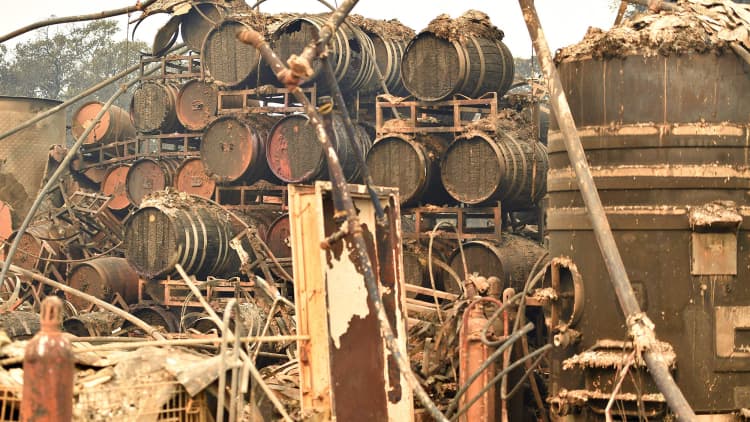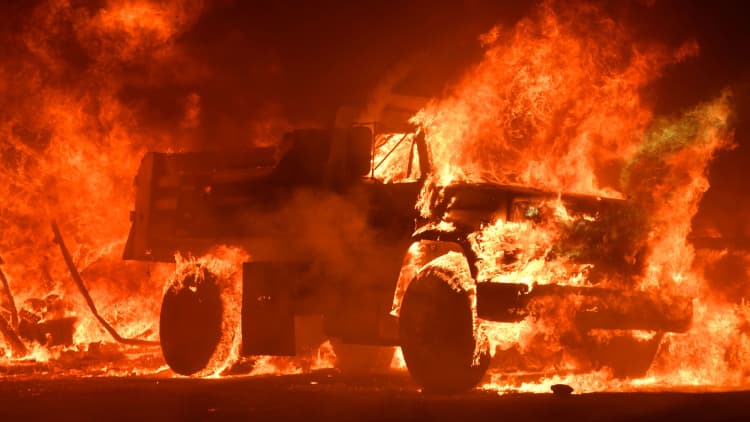Even as firefighters continue battling devastating blazes in Northern California, there is concern about the longer-term impacts the disaster will have on the region's economy and whether it will bring fiscal woes to local governments.
The rebuilding effort is likely to take years and pose challenges to localities since there are thousands of homes and other structures lost that could deal a blow to property tax revenues. There's also the added concern that the $2 billion in tourism-related income from region's winery tours, restaurants and hotels is at risk.

In a report Friday, S&P Global Ratings estimated there are 77 local government entities that have debt it rates located within or near uncontained fires in California. S&P didn't make any rating changes at this time, but said there's longer term concerns and questions.
"While natural disasters such as floods, fires, and earthquakes can exert some short-term pressure on municipal finances, the arrival of state and federal aid, insurance proceeds, access to short-term financing, and the use of a locality's own reserves typically alleviate the strain," said S&P.
Added the New York ratings firm, "The larger question, in our view, is how such local government entities will fare in the longer term, and if the disaster and subsequent rebuilding (or lack thereof) affects their tax bases and local economies."
The fires are raging in the wine country of Northern California, including Napa, Sonoma and Mendocino counties, and have already charred 222,000 acres and destroyed 5,700 homes and structures, according to estimates. The disaster also has killed at least 35 people, and hundreds are reported missing.
RMS, the risk modeling firm, Thursday put economic losses of the Northern California fires at a range of between $3 billion to $6 billion but it could rise since the fires still are burning.
The fires also are impacting California's Yuba, Lake, Solano and Nevada counties in the north as well as Orange County in the south. In all, California Gov. Jerry Brown has declared a state of emergency in 10 counties where the fires have been burning.
"The current fires ravaging northern and southern California are on pace to be among the worst in history," said S&P. "The loss of lives, infrastructure and potential environmental damage will take years to recover from."
The fires are in areas where agriculture is a major part of the local economy, from fruit and nut crops to livestock and poultry. Other than wine grape production, there is acreage devoted to pears, almonds, olives and walnuts, among other crops.
"Municipalities centered on agriculture could have a longer path to recovery," S&P said. It said at least 11 wineries have been directly affected by the fires.
The fires have destroyed vineyards and there's been concern that smoke from the fires could cause damage to the grapes that have yet to be picked.

Years of drought conditions in the state have left dry brush and dead trees that have helped fuel the fires. The drought ended in most areas of the state this year after heavy rains in the winter and spring, but that also produced abundant grass adding to the fire risk.
Timber production is significant in some of the wildfire areas, particularly Mendocino County. And some of that wood could end up going to rebuild homes lost to the fires.
"While we anticipate rebuilding to take place within two to four years, supplies of workers and other resources can affect rebuilding, as resources can become scarce given the magnitude of the fires and other recent natural disasters," said S&P.
Despite short-term challenges in the rebuilding process, there could be positive impacts longer term on property tax revenues for impacted communities. California cities and counties rely on property taxes for revenue as well as sales and other taxes.
Historically, major fires in the state have had a favorable impact on assessed value trends since rebuilt parcels end up having "equal or higher value than the structures lost," according to S&P.
Meantime, the ratings firm said it is "currently identifying issuers with the highest risk of immediate credit deterioration, which primarily include those that have relatively low liquidity or a weaker financial position, or those where the fire has had an acute impact on the ability to collect revenues. We are also examining past fire and disaster scenarios to estimate the disasters' long-term economic effect."
It singled out the city of Santa Rosa, saying it is "one of the most damaged cities within the active fire area; it has lost thousands of homes, several commercial properties, and two hotels."
Finally, the ratings agency didn't provide an estimate on the economic damages statewide from the current California fires but pointed out the 1991 Oakland fire produced damages as high as $3.4 billion, based on 2017 dollars. The Oakland fire destroyed more than 3,000 structures and also caused at least 25 fatalities.
"Given the current damage and low levels of containment, we expect the current fires to exact at least similar levels of economic damage, and likely significantly more," S&P said.
WATCH: Wildfires impact on wine industry



